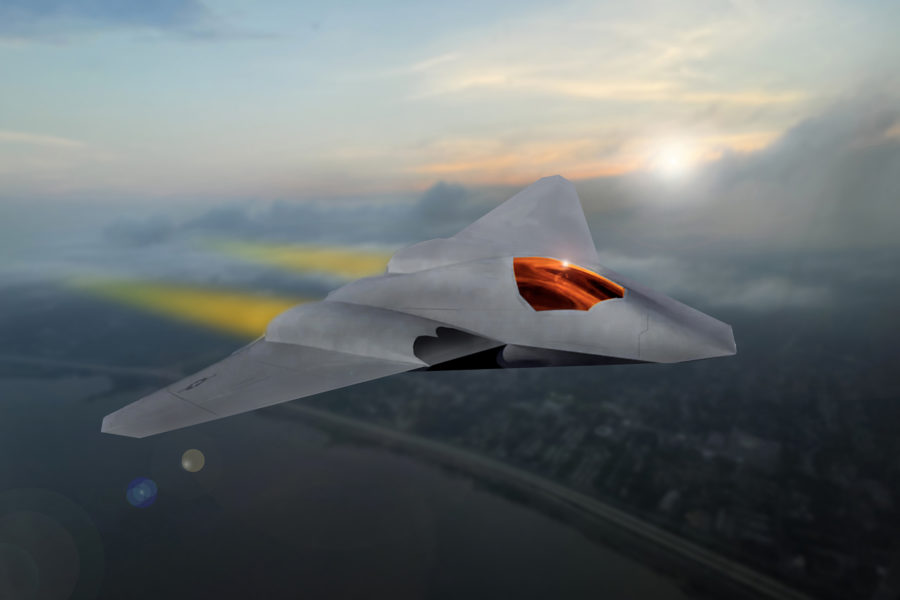Only one company will be chosen next year as the overall designer and developer of the Next Generation Air Dominance (NGAD) crewed fighter, despite years of prototype work on different designs by several companies, Air Force Secretary Frank Kendall said May 22.
Kendall added that there will be ongoing competition to supply NGAD’s systems after an overall winner is picked—but the original NGAD concept of rolling competitions, producing a series of incrementally better platforms, is too costly, he revealed.
“We’re not going to do two NGADs. We’re only going to do one,” Kendall said at a meeting of the Defense Writers Group in Washington, D.C.
Kendall told Air & Space Forces Magazine the original concept of rapidly-iterated NGADs, with competitions every few years—promoted by former Air Force acquisition executive Will Roper and meant to provide steady work to contractors to preserve their industrial capability—has been abandoned.
The NGAD’s “development phase is far too expensive,” to pursue such a strategy, he told Air & Space Forces Magazine. Such an approach is “not going to work, but we are going to design for modular open systems, on a number of [onboard] technologies, and that will remain competitive,” he added.
The Air Force released a classified solicitation for NGAD engineering and manufacturing development proposals May 18, saying a winner will be selected in 2024, but few new details of the highly classified program were released beyond that.
Even the size of the fleet remains publicly uncertain—Kendall has said a “notional” buy could number about 200 aircraft, but Air Force experts have said 250 is the more likely objective, as the minimum number of aircraft necessary to cover peacetime obligations along with minimal wartime surge capability.
Regardless, Kendall also said he is less concerned about the Air Force’s force structure—the number of aircraft and systems it has—than about modernization, which he said has been neglected for too long. China has been aggressively advancing its capabilities in air superiority and air defense, and “we have not responded as quickly as we should have,” he said.
As a result, Kendall said he is “prepared to take some risk” on the service’s force structure, but not with its modernization. The Air Force can only afford to field systems “that scare China” and contribute to deterrence, he said.
NGAD is key to that plan, as reflected in its planned capabilities the Air Force laid out in the May 18 announcement, such as enhanced lethality and the abilities to survive, persist, interoperate, and adapt in the air domain, all within highly-contested operational environments.
Kendall offered other details May 22, noting his own his history with NGAD dating back to his time undersecretary of defense for acquisition, technology, and logistics in the Obama administration.
“I started a program called the Aerospace Innovation Initiative, which was to get to the sixth-generation set of technologies we would need for future air dominance, and to build flying prototypes—X-planes, if you will—to bring those technologies forward,” he said.
That initiative resulted in a 2015 contract that produced experimental prototypes and verified new technologies. Those prototypes formed the basis of NGAD, Kendall said.
Since then, he added, “model-based system engineering and digitalization … moved forward a significant amount, so that we could integrate our design teams between the government and contractors much more effectively and efficiently.”
Both the contractors and government officials work in a common design environment, giving the Air Force an “intimate” knowledge of each competitor is doing, Kendall said. The service even has teams working with each company.
The Air Force won’t repeat the “serious mistake” it made with the F-35, Kendall said—allowing one company to own the technical baseline of the aircraft, thus controlling the program’s life cycle and creating “a perpetual monopoly” on sustainment and future modifications and upgrades.
“We’re not going to do that,” he said. “We’re going to make sure that the government has ownership for the intellectual property it needs. We’re going to make sure … we have modular designs and open systems so that, going forward, we can bring new suppliers in.”
Whoever is chosen “as the platform integrator … will have a much tighter degree of government control over the future of that program than we’ve had” with the F-35, he said. “We’ve learned that lesson.”
Kendall also said the Rapid Capabilities Office will not be brought in to manage the NGAD program, despite its apparent success on the B-21.
Instead, Brig. Gen. Dale White, program executive officer for fighters and advanced aircraft, and his office will oversee the effort, in addition to their management of the Collaborative Combat Aircraft program. Kendall said NGAD and CCA will be developed “in parallel,” but he declined to say when a contract award for the CCA program might be awarded.
